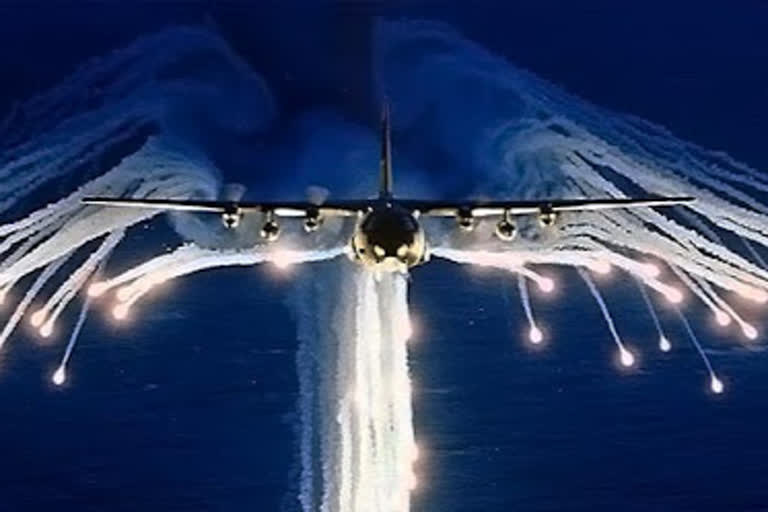New Delhi:Those few minutes during takeoff may be the longest for pilots these days flying out an aircraft out from the Hamid Karzai International airport in Kabul. Because on the ground, the Taliban and numerous insurgent outfits in Afghanistan are armed with deadly Man-Portable Air Defense Systems (MANPADS) that seem to be aplenty in the war-ravaged country.
Not weaponised aircraft, tanks, the thousands of Humvees, or the lakhs of assault rifles and armour-piercing ammunition that have fallen into Taliban hands, the lightweight ‘fire-and-forget’ MANPADS are the biggest cause of serious concern now for aircraft operating from the never-so-busy airport.
To counter threats from such incoming missiles, aircrafts are taking recourse to dropping infra-red flares even as they take off. These decoy flares that produce stronger infra-red signal than the aircraft themselves are meant to veer off any incoming infra-red seeking missile from the aircraft’s engine and explode harmlessly into the decoy flare.
It is thanks to the American and the Russian legacy that these easy-to-carry, shoulder-launched infra-red (heat sensitive) seeking missiles are terrifying aircraft of about 26 countries operating round-the-clock trying to emergency evacuate people out of the war-torn country.
Operated by a single individual, a fully-assembled MANPADS weighs 15–20 kg and is at most 2 metres long. It consists of three components—the explosive projectile, the launch tube along with the grip and a battery unit to produce the needed electricity.
Usually, depending on the type, the effective range of MANPADS ranges 3-7 km and altitudes 10,000-15,000 feet which makes it very dangerous for low-flying aircraft and especially near take-off zones.
What has added to the latest scare is the belief that many of these US-supplied weapons fell into the hands of the Taliban after large numbers of the Afghanistan National Army (ANA) surrendered to the insurgents along with their weapons and war-like equipment.
Also read:For Taliban, upcoming 50-km China link will be road to redemption
In the past, US military intelligence had reported that the Quds Force, Iran’s elite force, may have also provided the Taliban with SA-7 MANPADS and also the requisite training to operate them.
Even though about 12 countries in the world produce MANPADS, about 105 countries have it in their weapons inventories. The US-made ‘Stinger’ and the Soviet 9K32 Strela-2 or simply ‘SA-7’ are among the most prolific that have proliferated the most in Afghanistan. The China-made ‘FN-16’ is the latest entrant to this deadly club.
In the first part of the 1980s, the US had supplied the Mujaheedin in Afghanistan with the Stingers to down Soviet helicopters and low-flying aircraft.
The dangers posed by MANPADS have multiplied because the number of military and civilian flights taking off from the Kabul airport have increased unprecedentedly. About 26 countries are operating flights round-the-clock to carry out the emergency evacuation of their own citizens, third country civilians, Afghan allies and vulnerable Afghans trapped inside the war-ravaged country.
Till Tuesday afternoon, in just the last ten days (from August 14-24), about 70,700 people have been flown out from the Kabul airport.
Addressing the media on Tuesday, President Joe Biden gave an indication of the effort involved: “In the past 12 hours, another 19 US military flights, 18 C-17s, and one C-130 carrying approximately 6,400 evacuees and 31 coalition flights carrying 5,600 people have left Kabul—just in the last 12 hours.”
Chillingly, he added, for good effect: “Every day we’re on the ground is another day we know that ISIS-K is seeking to target the airport and attack both US and Allied forces and innocent civilians.” ISIS-K stands for the Khorasan affiliate of the terror organization ISIS.
The Hamid Karzai International airport has possibly never been so busy as aircraft of at least 26 nations are operating round-the-clock trying to emergency evacuate their own citizens, third country civilians, and vulnerable Afghans frantically trying to fly out of the war-ravaged country.
All this is happening even as 6,000 US troops are managing airport and security operations around the Kabul airport. While troops of the US 82nd Airborne Division are securing the runway, the Army’s 10th Mountain Division are guarding the airport surroundings and the 24th Marine Expeditionary Unit is assisting in the civilian departure.
